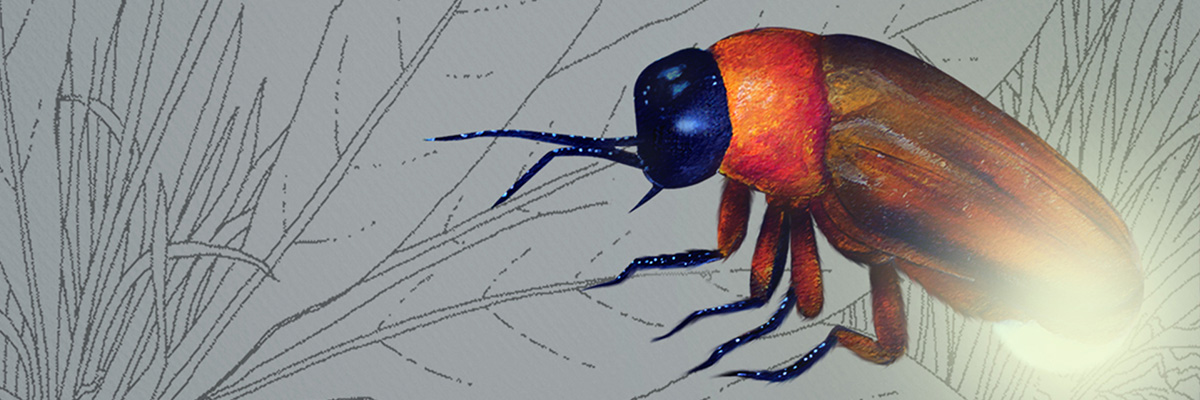| Golden Birdwing Golden Birdwing, flying as dazzling as a real bird under the sun, is an endemic species of butterfly found in the low altitude areas of southeast Taiwan. Having once had its population decrease greatly due to the damage to its habitat and illegal captures by human beings, this beautiful species has recovered and can now be found in Kenting National Park, Shirding area and nursery gardens of Kenting National Park Headquarters throughout the year, especially during Spring and Autumn. |
Camaena Batanica Pancala On the tree branches in Kenting, numerous wet and shining traces may catch your attention. These are the marks left by Camaena Batanica Pancala, an endemic species of snails in Taiwan. Their beautiful brown and white spiral shell patterns enchant and intrigue us to imagine secret behind their slow pace of life. |
| Megacrania Tsudai Megacrania Tsudai is one of few insects that can secrete chemical substances, making these unique stick insects famous. When encountering a natural enemy, it will -- similar to a whale -- spurt out a milky white substance that contains Actinidine, known for its prominent mint scent. The Megacrania Tsudai belonging to one of Taiwan’s rare and valuable species, and its distribution is restricted to Kenting and Green Island. |
Taiwan Bulbul The Taiwan Bulbul is an endemic species of bird in Taiwan. Its dark feathers, distinctive “mustache,” and vigorous personality are what make this species different from other Bulbul birds. During the breeding season, Taiwan Bulbuls fly in pairs, allowing visitors traveling to Pingtung to witness their chatter and activities. |
| Diospyros Philippensis Diospyros Philippensis, also known as Black Ebony, generates high economic value for the Shirding tribe in Kenting, who are responsible for Taiwan’s largest Diospyros Philippensis Wild Forest. This mysterious forest has a history of almost 100 years, dating from the Japanese rule in Taiwan. Nowadays, visitors can see herds of deer chasing and playing in the Formosan Sika Deer Restoration Area and observe the large leaf red fruit fig so large that it requires 10 people to encircle its base. |
Indian Barringtonia Originating from the Philippines, the Indian Barringtonia made its way across the sea and chose to blossom in the cool summer nights in Southern Taiwan. From nightfall to the early morning, it gradually blooms with small pink flowers and therefore is also known as the “Queen of Night Flowers.” This night-blossoming flower of Kenting makes the nights of southern Taiwan far more beautiful than mornings, in the hot summertime. |
| Fluorescent Mushroom After the summer rain, hidden within the bamboo forests, lie the fluorescent mushrooms. These mushrooms use their fluorescent hyphae to attract the consumption of nocturnal animals, in order to spread their spores and maximize their survival. Walking through the forest at night is like roaming through a star scattered ground, mysterious and attractive. |
Fireflies Fireflies can only survive in areas of clean and less urbanized environments. In the mating season, both male and female fireflies will make their tails glow like flying lanterns at night. In addition to Shirding Nature Park in Kenting, this special ecological phenomenon of fireflies in spring can also be found by the Lanren River and at Manzhou. |
| Formosan Rock Macaque Formosan rock macaques, a Taiwan endemic species, are both diurnal and social animals. They can usually be found in low altitude mountain areas, and Kenting is one of them. In the garden of GLORIA MANOR, you may sometimes see them gathering and eating fallen fruits. They will bring a smile to your face! |
Gray-faced Buzzard Eagle The fierce gray-faced buzzard eagle belongs to a species of migratory birds. The gray-faced buzzard eagle usually arrives in Taiwan in mid-September. Because its arrival time is around the National Day of Taiwan,it is also called “bird of national day.” The Ling-Xiao Pavilion inside Shirding Nature Park is the best place to observe the gray-faced buzzard eagle. Large flocks of birds flying up and down to follow the airstream are a spectacular sight. |
| Formosan Sika Deer Due to the damage of its habitats and hunting by humans, the number of Formosan sika deer has decreased gradually. In 1984, Kenting National Park started a project of sika deer recovery. At present, the east side of Shirding Nature Park is reserved as the area for sika deer recovery. Near the Long-Zi-Pu Grasslands, there are also flocks of sika deer which have been released into the wild after restoration. Visitors are invited to participate in Sika Deer Tours organized by the Shirding tribe to observe their unique and charming movements. |
Land Crabs Kenting has 30 species of land crabs in six families. This level of diversity in types of land crabs is found nowhere else in the world! Each summer, land crabs have to go across the Ping-E Highway to the seashore to lay their eggs. However, when crossing the highway, they are usually killed by vehicles passing by. In view of this, Kenting National Park Headquarters closes part of the highway during the breeding season (around the full moon between July and September of the lunar calendar), so that more land crabs can go back to the seashore to lay eggs and more people can observe their efforts to survive and multiply. |
Introduction to In-Depth Travel Activities in Kenting Exclusive "All Inclusive Local Tours Package"


















